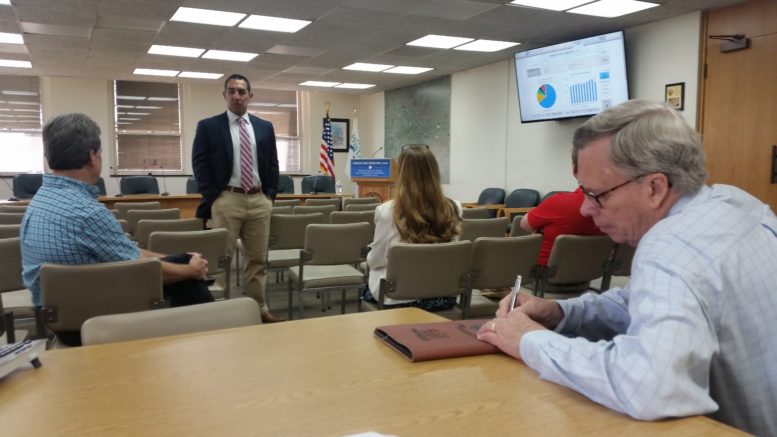By JAN LARSON McLAUGHLIN
BG Independent News
Taxpayers interested in how much the city of Bowling Green spends on paper, paint and Panera can now get a look at the city’s checkbook.
The city has joined other governmental entities in the state posting expenses online on OhioCheckbook.com through a program offered by the Ohio Treasurer’s Office.
The city’s bills have never been top secret information, but they also haven’t been really accessible to the average citizen. The online checkbook puts the numbers right at taxpayers’ fingertips.
“This information has always been available,” Bowling Green Mayor Dick Edwards said Friday morning during at visit from staff representing State Treasurer Josh Mandel’s office. “We’ve always had an open book philosophy. But you’ve taken it to a whole other level with technology.”
The Ohio Checkbook program went live in December of 2014. Since then, more than 1,100 of the 4,000 local governmental entities in Ohio have signed up to have their expenditures displayed online.
“We’re a public entity and it’s public information,” said Brian Bushong, finance director for the city of Bowling Green. “If we can make it easier for people to look at the information, it’s a great tool.”
In Wood County, the expenses for several entities are already online through the checkbook program, including, Wood County, Rossford, Cygnet, North Baltimore, Bradner, Haskins, Luckey, Risingsun, West Millgrove, Weston, Webster Township, Northwood School District, North Baltimore School District, Otsego School District, Rossford Schools, North Baltimore Public Library and Fort Meigs Cemetery. Bowling Green State University was the first of the state universities to become part of the program.
“It’s been amazing to me how many entities have bought into the system,” Edwards said.
It allows people to follow the money – at least the outgoing money. The incoming revenue is not tracked. The system, which went live in December of 2014 for the state, allowed Ohio to “set a new standard” in transparency, according to Dan Risko, deputy director of public affairs for the Ohio Treasurer’s Office.
Prior to the online checkbook, Ohio was ranked 46 among the states in governmental transparency by the U.S. Public Interest Research Group, Risko said. Ohio now ranks number 1 in the nation, he added.
In 2015, other governmental units were invited to join in – cities, villages, township, school districts and other entities.
“Ohio is leading the way in governmental transparency,” Risko said.
Though the city of Bowling Green just joined, the past three years of spending are posted. Listed are more than 61,000 transactions that cover approximately $291 million in those three years.
The records show how each department spends its money, and exactly where the money is going. So, by typing in a certain business, like Staples or John Deere, citizens can see how much city money is going to which businesses.
“We wanted the users to be able to see this,” Risko said. “You don’t have to be an account funding expert to know what you are looking at.”
Ohio citizens seem to be receptive to the online checkbook, since the system has logged more than 780,000 searches for the state records since it went live.
Local residents can access the information by going to the state site, OhioCheckbook.com, visiting the local government option, then clicking on Bowling Green. Bushong hopes to have a link on the city’s website soon.

